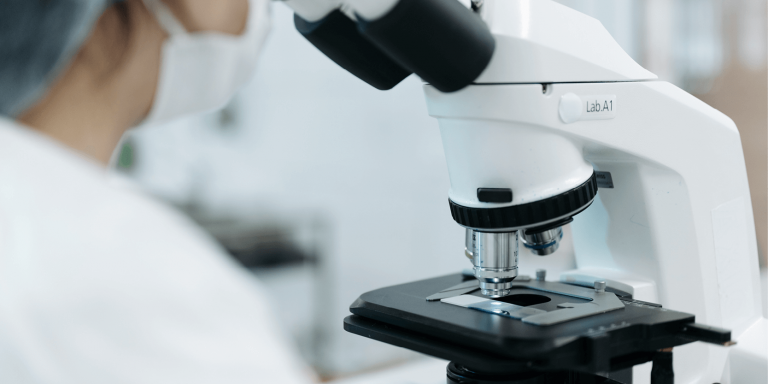
Researchers from the Imaging and Modeling Unit at Institut Pasteur, led by Christophe Zimmer, propose ShareLoc.XYZ, an open platform for sharing single molecule localization microscopy data and tools. It will allow access to large collections of images produced by super-resolution microscopy and, thanks to the progressive accumulation of data, will allow to train a deep learning algorithm, in particular to accelerate super-resolution imaging.
Super-resolution single molecule localization microscopy (SMLM) allows to reach a resolution of up to 20 nm, which is about ten times better than conventional optical microscopy.
Christophe Zimmer explains:
“Conventional optical microscopes can distinguish structures in the 200-300 nm range, but not below that. Smaller objects appear as a spot of light under the microscope, we cannot distinguish their internal structure. This is the case, for example, for the capsid of the AIDS virus, which is cone-shaped, or for nuclear pores, which are octagon-shaped. In both cases, with a conventional microscope, you can only see a diffuse spot.
SMLM is widely used in biology, but most of the images produced are not shared with the scientific community, although they could be used to train algorithms to accelerate super-resolution imaging or to analyze molecular structures. To overcome this problem, Christophe Zimmer and his team are proposing a platform to gather all the images produced by SMLM microscopy.
Accelerating SMLM thanks to deep learning
The speed of SMLM methods such as PALM and STORM is limited by the need to acquire up to tens of thousands of conventional resolution images to obtain a single super-resolution image. To remedy this, Christophe Zimmer and his team at the Imaging and Modeling Unit at the Institut Pasteur, had, in 2018, developed the ANNAPALM method. It uses deep learning to reconstruct SMLM images from sparse and rapidly acquired localization images and/or wide-field images in a much shorter time than in conventional super-resolution microscopy. So much so that “we accelerated super-resolution imaging of microtubules by about 100 times,” explains Christophe Zimmer.
The need for data sharing
For a deep learning algorithm to perform well, it must be trained on large amounts of highly varied data. However, although numerous, the SMLM data are not widely shared by laboratories, in part because of the large size of each file (on the order of a DVD for each super-resolution image).
To facilitate data sharing, the researchers propose ShareLoc.XYZ, an online platform for viewing, annotating, and sharing 2D or 3D SMLM images. To avoid loading times that can sometimes exceed one hour, the images are visualized according to a dynamic loading principle, similar to that of Google Maps.
The team hopes to collect thousands of images, for the moment, hundreds from six laboratories are already available. The ultimate goal will be not only to train ANNAPALM and other similar software, but also to offer a collection of high-resolution molecular structures useful for other research purposes, such as searching for similar structures from other molecules or biological species.
Christophe Zimmer concludes:
“Eventually, ShareLoc may serve as the basis for algorithms to predict the function of poorly known molecules from their super-resolution images.”
Article sources:
“ShareLoc – an open platform for sharing localization microscopy data”
Nature Methods doi.org/10.1038/s41592-022-01659-0 October 21, 2022
Wei Ouyang1,2#*, Jiachuan Bai1,3#, Manish Kumar Singh1,4, Christophe Leterrier5, Paul Barthelemy6, Samuel F.H. Barnett8,9,10, Teresa Klein7, Markus Sauer7, Pakorn Kanchanawong8,9, Nicolas Bourg6, Mickael M. Cohen4, Benoît Lelandais1, Christophe Zimmer1*
1InstitutPasteur, Université de Paris Cité, Unité Imagerie et Modélisation, F-75015 Paris, France
2Sciencefor Life Laboratory, School of Engineering Sciences in Chemistry, Biotechnology and Health, KTH – Royal Institute of Technology, Stockholm, Sweden
3SorbonneUniversity, Doctoral College, F-75005 Paris, France
4Laboratoryof Molecular and Cellular Biology of Eukaryotes, Sorbonne University, CNRS, UMR8226, Institute of Physical and Chemical Biology, 75005 Paris, France.
5AixMarseille University, CNRS, INP UMR7051, NeuroCyto, Marseille 13005, France
6Abbelight, Cachan, France
7Departmentof Biotechnology and Biophysics Biocenter, University of Würzburg, Würzburg, Germany.
8MechanobiologyInstitute, National University of Singapore, Singapore 117411, Singapore.
9Departmentof Biomedical Engineering, National University of Singapore, Singapore 117411, Singapore.
10presentaddress: Max Planck Institute for Medical Research, Heidelberg 69120, Germany
#Equalcontribution
Translated from Des chercheurs de l’Institut Pasteur lancent une plateforme ouverte de partage de données de microscopie super-résolutive









